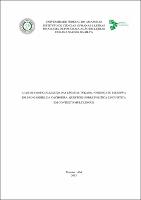| ???jsp.display-item.social.title??? |


|
Please use this identifier to cite or link to this item:
https://tede.ufam.edu.br/handle/tede/3995| ???metadata.dc.type???: | Dissertação |
| Title: | A lei de cooficialização das línguas Tukano, Nheengatu e Baniwa em São Gabriel da Cachoeira: questões sobre política linguística em contexto multilíngue. |
| ???metadata.dc.creator???: | Silva, Fabiana Sarges da  |
| ???metadata.dc.contributor.advisor1???: | Pacheco, Frantomé Bezerra |
| ???metadata.dc.contributor.referee1???: | Silva, Raynice Geraldine Pereira da |
| ???metadata.dc.contributor.referee2???: | Bruno, Ana Carla dos Santos |
| ???metadata.dc.description.resumo???: | Localizado no Noroeste Amazônico, no Alto Rio Negro, o município de São Gabriel da Cachoeira apresenta uma realidade sociolinguística complexa por apresentar uma grande diversidade de etnias, línguas e culturas. São cinco as famílias linguísticas presentes na região que se dividem em vários grupos étnicos. Cada família linguística se concentra em maior número de pessoas em uma das calhas de rio: Uaupés, Içana e Rio Negro e Xié. Dessa maneira, as calhas de rio apresentam uma língua predominante que serve para a comunicação interétnica. Assim, temos o Tukano na bacia do Uaupés, o Nheengatu nos rios Negro e Xié e Baniwa no rio Içana. Após muitas discussões por parte das lideranças indígenas e algumas instituições e organizações (IPOL, ISA, UFAM, FOIRN) oficializou-se essas três línguas indígenas em nível municipal na lei 145/2002 e, após alguns anos, regulamentou-se na lei 210/2006. Neste trabalho tentamos analisar as representações que a lei de cooficialização e sua regulamentação possuem para os agentes sociais que vivenciam o processo de implementação da Lei. Durante o desenvolvimento do estudo verificamos como estão sendo desenvolvidas as ações que operacionalizam a política de cooficialização das línguas Tukano, Nheengatu e Baniwa, bem como o uso dessas e das demais línguas indígenas nos contextos diversos do município de São Gabriel da Cachoeira, interior do estado do Amazonas. Partiu-se do ponto de vista dos professores indígenas participantes dos cursos de licenciatura do PARFOR – Plano Nacional de Formação de Professores de Educação Básica – que, através das respostas dadas ao questionário aplicado, aliadas as entrevistas realizadas com ex-vereadores e diretores da FOIRN – Federação das Organizações Indígenas do Rio Negro, permitiu que fosse analisadas as representações, o conhecimento, opinião e atitudes acerca da política de cooficialização local, além de caracterizar o uso de outras línguas por essas pessoas. As respostas são estabelecidas por meio da interação dialógica que se apresentam em contextos de enunciações contornados pelo social. |
| Abstract: | The municipality of São Gabriel da Cachoeira located on the Rio Negro in the Northwest Amazon, is home a diverse range of ethnic groups, languages, and cultures, forming a complex sociolinguistic reality. There are five language families in the region that are divided into several ethnic groups. Each language family is concentrated in one of the three main tributary river systems: Uaupés, Içana and Rio Negro/Xié. In this way, one language is predominant for interethnic communication in each of these river systems – Tukano in the Uaupés basin, Nheengatú along the Negro and Xié, and Baniwa along the Içana. After much discussion by the indigenous leaders and some institutions and organizations (IPOL, ISA, UFAM, FOIRN) these three languages were granted official status at the municipal level in the law 145/2002, which, after a few years, was regulated by the law 210/2006. In this thesis, I will analyze what the officialization law and its regulations represent for the social agents who are experiencing the process of its implementation. Throughout the study, I observed how actions are being developed to operationalize the policy cooficializing the Tukano, Nheengatú, and Baniwa languages, as well as the use of these and other indigenous languages in various contexts in the municipality of São Gabriel da Cachoeira. This study provides the perspectives of indigenous teachers participating in the PARFOR undergraduate program (a national program providing basic teacher training education), obtained through the use of a questionnaire. In addition, interviews were conducted with FOIRN (the Federation of Indigenous Organizations of the Rio Negro) directors and with former municipal councilors who had been involved in the development of this law. In the results presented here, I analyze the representations, knowledge, beliefs, and attidudes these people have about the coofficialization policy, in addition to characterizing their use of other languages. I will show how these two sources of information – survey responses and interview responses – work in dialogical interaction with one another, and situate both within a broader social context. |
| Keywords: | Antropologia linguística Linguagem e cultura Professores indígenas multilingualism language policy co-oficialization indigenous teachers dialogical interaction polyphony |
| ???metadata.dc.subject.cnpq???: | LINGUÍSTICA, LETRAS E ARTES: LETRAS |
| Language: | por |
| ???metadata.dc.publisher.country???: | Brasil |
| Publisher: | Universidade Federal do Amazonas |
| ???metadata.dc.publisher.initials???: | UFAM |
| ???metadata.dc.publisher.department???: | Instituto de Ciências Humanas e Letras |
| ???metadata.dc.publisher.program???: | Programa de Pós-graduação em Letras |
| Citation: | SILVA, Fabiana Sarges da Silva. A lei de cooficialização das línguas Tukano, Nheengatu e Baniwa em São Gabriel da Cachoeira: questões sobre política linguística em contexto multilíngue. 2013. 192f. Dissertação (Mestrado em Letras) - Universidade Federal do Amazonas, Manaus, 2013. |
| ???metadata.dc.rights???: | Acesso Aberto |
| URI: | http://tede.ufam.edu.br/handle/tede/3995 |
| Issue Date: | 7-Nov-2013 |
| Appears in Collections: | Mestrado em Letras |
Files in This Item:
| File | Description | Size | Format | |
|---|---|---|---|---|
| Dissertação - Fabiana Sarges da Silva.pdf | Dissertação - Fabiana Sarges da Silva | 11.69 MB | Adobe PDF |  Download/Open Preview |
Items in DSpace are protected by copyright, with all rights reserved, unless otherwise indicated.




